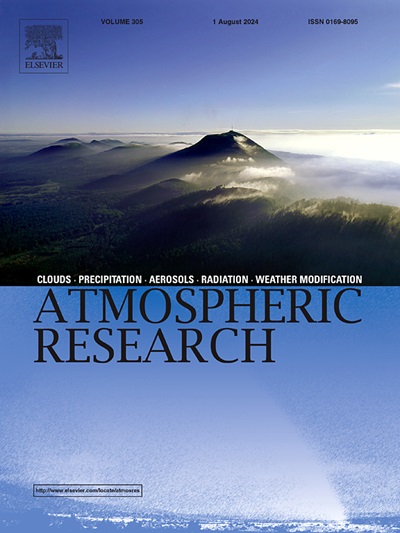1961 - 2014年人类活动对西北地区夏季湿润的影响:温室气体和人为气溶胶的作用
IF 4.4
2区 地球科学
Q1 METEOROLOGY & ATMOSPHERIC SCIENCES
引用次数: 0
摘要
1961 - 2014年,西北地区夏季降水显著增加,给当地生态系统和人类社会带来了机遇和挑战。通过多模式工业化前控制模拟,以及来自最先进的MIROC6模式的历史和单一强迫模拟,我们将这种湿润趋势归因于此,并探讨了各个外部强迫的相对作用。我们的发现表明,外部强迫是这种观测到的湿润的主要驱动因素,而人为强迫——以温室气体(GHG)为主,其次是人为气溶胶(AA)——比自然强迫发挥更大的作用。水汽收支分析表明,环流变化驱动的水汽通量辐合增强是温室气体和AA模拟中NWC变湿的关键机制。具体来说,温室气体强迫改变了亚洲副热带西风急流(ASWJ),导致西风急流西支南移,东支减弱。这些变化对应于北大陆架西(东)有一个异常气旋(反气旋),促进了异常西南风和东南风在北大陆架上空的水汽辐合。AA强迫减弱了ASWJ,在北(南)产生了一个经向偶极子型的异常反气旋(气旋),同时在蒙古和中国东北上空产生了低层异常反气旋。这种环流模式有利于水汽通过异常东风从北太平洋西部输送到北太平洋内陆,并增强水汽通量辐合。本文章由计算机程序翻译,如有差异,请以英文原文为准。
Human influence on summer wetting in Northwest China from 1961 to 2014: Roles of greenhouse gases and anthropogenic aerosols
A significant increase in summer precipitation was observed in Northwest China (NWC) from 1961 to 2014, posing opportunities and challenges for the local ecosystem and human society. Using multi-model pre-industrial control simulations, and historical and single-forcing simulations from the state-of-the-art MIROC6 model, we attributed this wetting trend and explored the relative roles of individual external forcings. Our finding indicated that external forcing is the primary driver of this observed wetting, with anthropogenic forcing—dominated by greenhouse gases (GHG) and secondarily by anthropogenic aerosols (AA)—playing a significant role than natural forcing. Moisture budget analysis indicated that intensified moisture flux convergence, driven by circulation changes, is a key mechanism behind the NWC wetting in both GHG and AA simulations. Specifically, GHG forcing alters the Asian subtropical westerly jet (ASWJ), inducing a southward shift of the western branch and a weakening of the eastern branch. These changes correspond to an anomalous cyclone (anticyclone) in the west (east) of NWC, promoting moisture convergence over NWC of anomalous southwesterly and southeasterly winds. AA forcing weakens the ASWJ, producing a meridional dipole pattern of an anomalous anticyclone (cyclone) in the north (south), along with lower-level anomalous anticyclone over Mongolia and Northeast China. This circulation pattern facilitates moisture transport from the western North Pacific into inland NWC via anomalous easterlies and intensified moisture flux convergence.
求助全文
通过发布文献求助,成功后即可免费获取论文全文。
去求助
来源期刊

Atmospheric Research
地学-气象与大气科学
CiteScore
9.40
自引率
10.90%
发文量
460
审稿时长
47 days
期刊介绍:
The journal publishes scientific papers (research papers, review articles, letters and notes) dealing with the part of the atmosphere where meteorological events occur. Attention is given to all processes extending from the earth surface to the tropopause, but special emphasis continues to be devoted to the physics of clouds, mesoscale meteorology and air pollution, i.e. atmospheric aerosols; microphysical processes; cloud dynamics and thermodynamics; numerical simulation, climatology, climate change and weather modification.
 求助内容:
求助内容: 应助结果提醒方式:
应助结果提醒方式:


